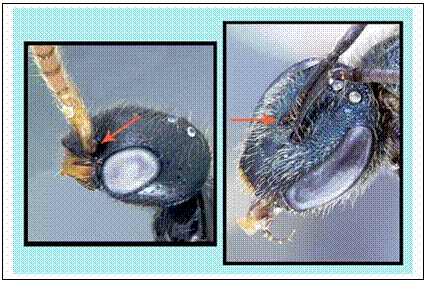Katja Seltmann
| University of S-225 Ag. Sciences Center North MOon@uky.edu |  |
Education:
January 2002—
Dr. Michael Sharkey
Accepted for the Masters Program
in Entomology
Winter 1993-Winter 1998
1995-1996
Ecole d’Art d’Aix en
Guest student and artist’s
assistant at this institute for art and technology, Department of New Media
Fall 1990-Spring 1992
Current Research:
Dr. Michael Sharkey
Development
of interactive keys to the Hymenopteran families using D.E.L.T.A. (DEscription Language for Taxonomy). Photograph key characters using Auto-montage by Syncroscopy© and database these characters as part of the
Large Scale Phylogenetic Analysis of the Hymenoptera project. Make these keys
available on the internet for use by researchers, extension specialists and the
community.
Keys
are available at: http://www.uky.edu/~mjshar0/datasets/welcome.html
Publications:
Nowak, John. T., Christopher J. Fettig,
Kenneth W. McCravy, Christopher S. Asaro, Katja C. Seltmann, Richard C. Reardon & C. W. Berisford. 2001.
Guide to Common Natural Enemies of the
Sullivan, Brian T., Eva M. Petterson,
Katja Seltmann, & C.W. Berisford. 2000. Attraction of the Bark Beetle Parasitoid Roptrocerus xylophagorum
to Host-Associated Olfactory Cues. Environmental Entomology 29(6): 1138-1151.
Sullivan, Brian T., Katja Seltmann,
& C.W. Berisford.1999. A Simple and Continuous Rearing Technique for the Bark Beetle
Parasitoid, Roptrocerus xylophagorum.
Journal of Entomological Sciences 34(2): 260-264.
Presentations:
Professional:
Entomological
Society of
Entomological
Society of
Summer
Symposium of the Center for Ecology, Evolution and Behavior. Building a Pleasing Key to the Families of
Hymenoptera. 10 minute presentation. May,
2002.
Outreach/Community Service:
Outreach radio series. Entomelodical Moments.
Broadcast on WRFL 88.1 fm. Entomology graduate students are interviewed about
research projects,
Professional Employment:
Research Technician
Dr. Charles W. Berisford,
March 1998-Janurary 2002
Microsporidia LD50 studies with the
Roptrocerus xylophagorum project with Brian Sullivan Responsibilities included maintenance of a continuous
reared colony of pine beetle parasitoid Roptrocerus
xylophagorum and pine beetle host Ips granicollis. Supplying the insects with basic needs, assessing the colony vigor,
and diagnosis of present or potential problems within the colony. Bioassays using a Y-tube olfactometer, experiencing female R. xylophagorum
prior to experimentation, observing and recording behavior and behavioral
changes in R. xylophagorum and
Identification
of southern pine infesting insects and their related parasitoids. Population trends of common
Maintain domestic and exotic
live specimens for the Entomology Department’s "Insect Zoo", used
during outreach programs.
Research Assistant
Dr. Michael Adang, May 1997-1999
Primary job rearing a Bacillus
thuringiensis resistant, sustainable, colony of Heliothis virescens,
bioassay the colonies progress, carry out selection and fecundity experiments,
observe and diagnose current and potential problems in colonies and rearing
techniques.
Rearing multiple species of
insects including Manduca sexta, Ostrinia nubilalis, Diabrotica virgifera, Spodoptera exigua, Heliothis zea and Plutella xylostella
Dissection
of insects to obtain the larval mid-gut. Mid-gut and whole insect body isolation of brush
border membranes, qualified enzyme activity in insect tissue and determination
of protein concentration by quantitated aminopeptidase Bradford Assay.
Research Assistant
Dr. Fred Gould, 1989-1992
Worked primarily with
graduate student Tracy Johnson
Responsibilities included
colonies of H. virescens parasitoids, Campoletis sonorensis
and Cardiochiles nigericepts
Laboratory and field
observations of parasitoids and behavioral interrelations with H. virescens on toxic plants and/or in the presence of other
natural enemies
Research Assistant
Dr. George Kennedy, 1987-1989
General laboratory and field
responsibilities including identification of pests/natural enemies on major
crop species
Volunteer Curator
1984-1990
Care of rescued wildlife and
non-poisonous living displays
Assistant in outreach
programs
Travel including
Volunteer recognition award
1989
Memberships
The Begonia Society (www.begoniasociety.org)
Entomological Society of
Art
& Science Collaborations, Inc.